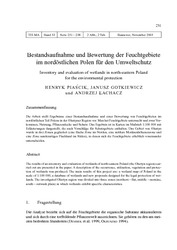Bestandsaufnahme und Bewertung der Feuchtgebiete im nordöstlichen Polen für den Umweltschutz
Piaścik, Henryk
Gotkiewicz, Janusz
Łachacz, Andrzej
33: 231 - 238
Piaścik, Henryk; Gotkiewicz, Janusz; Łachacz, Andrzej, 2003: Bestandsaufnahme und Bewertung der Feuchtgebiete im nordöstlichen Polen für den Umweltschutz. In: TELMA - Berichte der Deutschen Gesellschaft für Moor- und Torfkunde, Band 33: 231 - 238, DOI: 10.23689/fidgeo-3072.
 |
Dokument öffnen: |
Abstract:
The results of an inventory and evaluation of wetlands of north-eastern Poland (the Olsztyn region) carried out are presented in the paper. A description of the occurrence, utilisation, vegetation and protection of wetlands was produced. The main results of this project are: a wetland map of Poland in the scale of 1:100 000, a database of wetlands and new proposals designed for the legal protection of wetlands. The investigated Olsztyn region was divided into three zones (northern - flat, middle - moraine, south - outwash plain) in which wetlands exhibit specific characteristics. Zusammenfassung:
Die Arbeit stellt Ergebnisse einer Bestandsaufnahme und einer Bewertung von Feuchtgebieten im nordöstlichen Teil Polens in der Olsztyner Region vor. Man hat Feuchtgebiete untersucht und zwar Vorkommen, Nutzung, Pflanzendecke und Schutz. Das Ergebnis ist in Karten im Maßstab 1:100 000 mit Erläuterungen dargestellt, die auch Vorschläge für Schutzgebiete enthalten. Das Gebiet von Olsztyn wurde in drei Zonen gegliedert (eine flache Zone im Norden, eine mittlere Moränenhöhenenzone und eine Zone sanderartiges Flachland im Süden), in denen sich die Feuchtgebiete erheblich voneinander unterscheiden.

